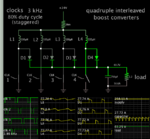emaq
Member level 4
I am looking for a DC-DC converter design with the following specifications.
Vin = 24 V
Iin = 135 A
Vout = 60 V
Iout = 50 A
Which topology will work in this case? Any design or schematic?
Vin = 24 V
Iin = 135 A
Vout = 60 V
Iout = 50 A
Which topology will work in this case? Any design or schematic?
